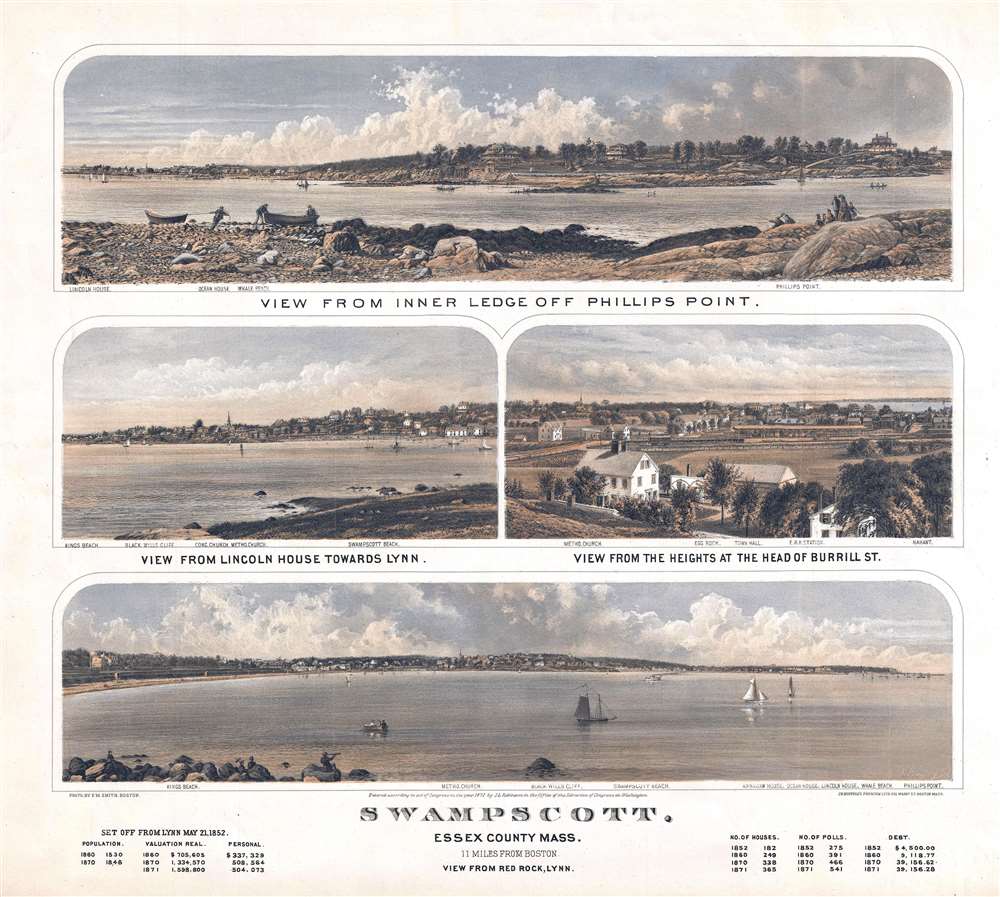1871 Robinson View of Swampscott, Massachusetts
Swampscott2-robinson-1871
Title
1871 (dated) 18 x 20 in (45.72 x 50.8 cm)
Description
A Closer Look
The piece consists of four views on a single sheet:- View from Inner Ledge of Phillips Point
- View from Lincoln House towards Lynn
- View from the Heights at the head of Burrill St.
- View from Red Rock, Lynn
Unusual Local Production
This view, unlike most 18th-century views, appears to be a highly localized production and lacks the sophistication of most commercial views of this era. For example, here Swampscott is illustrated by a low-angle elevation rather than a high bird's-eye perspective, as was more common. The photographer Frederick M. Smith is little known, but existing photographs bearing his imprint seem to suggest that he was a landscape photographer based in Lynn, Massachusetts (8 Market Street). The publisher, John L. Robinson, is similarly little known, but evidence suggests he was a local real estate investor. Robinson issued only three views, all in 1871, two of Swampscott and one of Lynn. All three feature real estate statistics in the lower margins. The lithographer, J. H. Bufford, is more prolific and managed a large Boston printing house.Swampscott
Swampscott was first settled in 1629 when Francis Ingalls built the first Massachusetts Bay Colony tannery on Humphrey’s Brook. It was not formally incorporated until 1852, at which point it was beginning to see wealthy tourists from Boston in the summer months. Abutting Salem, Marblehead, and Lynn, Swampscott, with its beautiful beaches, quickly became a haven for Boston's elite. It is considered by some to be America's first resort town. Enormous luxurious hotels, such as Ocean House, identified here at the left side of the top view, were constructed. Many who enjoyed Swampscott during the summer went on to build stately homes, among them General Electric founder Elihu Thomson’s Georgian revival mansion, now the town administration building.Publication History
This view is today rare. Examples are known at the Library of Congress and at the Boston Athenaeum.Cartographer
John Henry Bufford (July 27, 1810 - October 8, 1870) was a Boston based lithographer and printer. Bufford was born in Portsmouth, New Hampshire. He apprenticed as an artist and lithographer at Pendleton Lithography (1825 - 1836) of Boston. In 1835 he relocated to New York where he took independent commissions from George Endicott and Nathaniel Currier, among others. Returning to his hometown of Boston in 1839, he took a position of chief artist with the firm of Benjamin W. Thayer, heir to Pendleton Lithography. He probably married Thayer's sister, Anna Melora Tufts Thayer (1808-1878). Bufford has been highly criticized as an engraver, with one historian, David Tatham, stating he had 'a mediocre sort of craftsmanship at best' and 'no very special skills as an original artist.' We, however, find no justification for this harsh criticism. Instead Bufford gravitated toward business and management. By 1844 Thayer's shop was renamed J. H. Bufford and Company. The firm specialized in decorative sheet music, panoramic views, illustrations for books, retractions of paintings, and commercial printing. Bufford is credited with being one of the first employers and mentors of the important artist and engraver Winslow Homer. Bufford died in 1870, passing on the business to his sons Frank G. Bufford and John Henry Bufford Jr. These young men, operating under the imprint of 'J.H. Bufford's Sons, Manufacturing Publishers of Novelties in Fine Arts', expanded the firm with offices in New York and Chicago. A possibly related lithographic printing firm named Bufford Chandler was incorporated in Boston in 1893. It later relocated to Concord, New Hampshire but closed in 1925 when its state business charter was repealed. More by this mapmaker...

